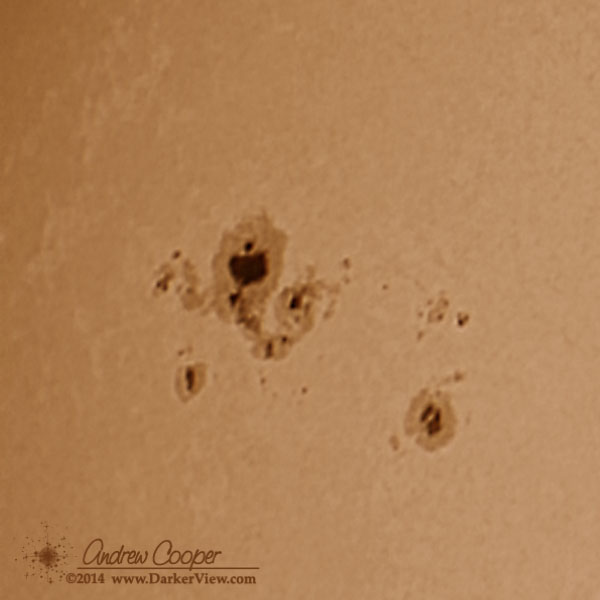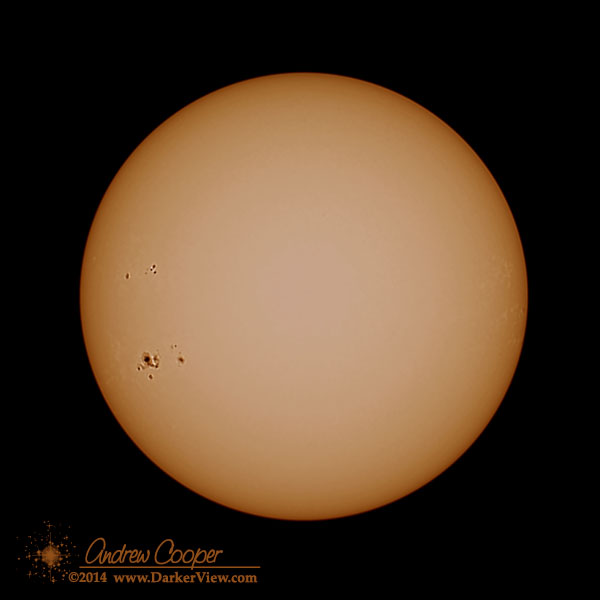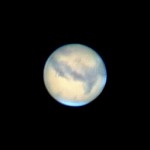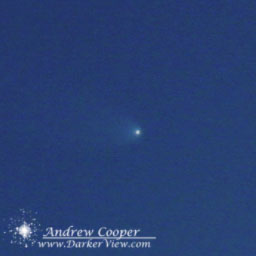A closer look at the sunspot complex AR1967. Image takes with an AT6RC telescope, a Baader film solar filter and a Canon 60D camera in 640×480 crop mode. The best 800 of 1200 images were stacked in RegiStax, final processing in Photoshop.

When you want to see the stars, find someplace dark
Another process run on the sunspot image I posted earlier, a stack of 800 out of 1200 frames, with notably better detail. The large complex is AR1967 just rotating into view. This spot has already spawned an M-class flare and more is likely. Forecasters have given the chances of more M-class flares at 60% with the chance of an X-class flare at 10%.

Some unaided eye sunspots visible today and for the next few days. The huge group, AR1967 is probably another visitation of AR1944, which spawned a few large solar flares during the first week of January.
I took a few quick images using the AT6RC and a Canon 60D. A quick process is shown below, give me a bit I should be able to produce a better image.

Today the Earth is closest to the Sun, a point called perihelion. We will be about 147,099,000km (91,403,000miles) from the Sun. Compare this to the 152,096,000km (94,508,000miles) we will be at aphelion on July 3rd, a difference of about 4,996,000km (3,104,000miles) occurs throughout one orbit.
It may seem odd that we are actually at the closest for the middle of northern winter, you just have to remember that proximity to the Sun is not the cause of the seasons. The seasons are caused by the axial tilt of the Earth, creating short and long days throughout the year, with a resulting change in the angle and intensity of the sunlight.
| 2014 Solstices and Equinoxes | ||||
|---|---|---|---|---|
| UT | HST | |||
| Perihelion | Jan 4 | 05:59UT | Jan 3 | 19:59HST |
| Vernal Equinox | Mar 20 | 16:57UT | Mar 20 | 06:57HST |
| Summer Solstice | Jun 21 | 10:52UT | Jun 21 | 00:52HST |
| Apehelion | Jul 3 | 22:59UT | Jul 3 | 12:59HST |
| Autumnal Equinox | Sep 23 | 02:30UT | Sep 22 | 16:30HST |
| Winter Solstice | Dec 21 | 23:03UT | Dec 21 | 13:03HST |
| Source: NASA Sky Calendar | ||||
What is happening in the sky this year?
There are no exceptional sky events expected in 2014. A pair of good lunar eclipses, a decent Mars opposition, the usual meteor showers, and no bright comets predicted. There is one odd meteor shower that might provide some fireworks in May mentioned below. Otherwise there is always the possibility of a new discovery, a nova or supernova, or a new comet. For now this looks to be a routine year for sky watchers.

Venus is as always a fun planet to follow through the year. The brilliant morning or evening star is always notable when it passes other bright objects such as the Moon or Jupiter. In April and May Venus will pass both ice giants, Uranus and Neptune with under a degree of separation. In August it will be Jupiter, passing about 35′ away on August 14th. The approach will be even closer if you are able to observe the pair during daylight hours, closing to 12′ at 08:06HST on the 14th.
Mars will pass through opposition on April 8th this year. This is a relatively good viewing opportunity with the red planet appearing just over 15″ in size. Close approach will be a week later, on April 14th. On September 27th Mars will pass about 3° from Antares.
Jupiter and Saturn continue to be well separated in the sky. This results in one or the other being available for observation much of the year. We start with Jupiter in the evening sky until early July. Saturn is currently in the early morning sky, passing through opposition May 10th and available for observation in the evening sky for the latter half of the year.
The minor planets Ceres and Vesta are quite close all year. So close they will experience opposition in the same week. The dance will take place with the constellation Virgo as the backdrop. 4 Vesta will pass through opposition on April 13th, only two days later 1 Ceres will do the same on the 15th. At the same time the planet Mars will be just a few degrees south of the pair, going through opposition on April 8th. I wonder if the astrologers have noticed this? If so I am sure they will attach some ridiculous speculations to the event. They do not usually pay attention to the minor planets.

There are two solar eclipses and two lunar eclipses for 2014. An odd annular solar eclipse will be visible from Antarctica and Australia on April 29th. A deep partial solar eclipse will be visible across much of western North America on October 23rd. Neither will be visible from the islands.
The two lunar eclipses are more interesting. Both total eclipses will feature good magnitudes and the eclipses will both be visible in their entirety from Hawai’i. Better yet, the first eclipse will begin soon after sunset, providing an excellent viewing opportunity for outreach. Occurring on April 14th and October 7th, these will be the highlight of the year for eclipse aficionados.
2014 offers an interesting year for meteor watchers. Of the three most reliable showers it is the Quadrantids that will be seen to best effect in 2014, untroubled by moonlight. The Geminids will be partly obscured, while the Perseids will peak quite close to full Moon.
In addition to the traditional showers there are predictions for a new shower associated with Comet 209P LINEAR. In late May this debris stream may produce a strong, or even storm level meteor shower. Watch here for more information on this possible event.
As usual you should keep tuned to Darker View for timely reminders of upcoming celestial events. Over a hundred posts are already entered and waiting for the appropriate date to pop up here, reminding you and I to keep looking up.
Winter solstice occurs today at 07:11HST. Today the Sun will occupy the most southerly position in the sky of the year. The term solstice comes from the Latin terms Sol (the Sun) and sistere (to stand still). On this day the Sun seems to stand still as it stops moving southwards each day and begins move to the north. This is the first day of winter as marked by many cultures in the northern hemisphere. Alternately, this is the first day of summer for those folks in the southern hemisphere.
| 2013 Solstices and Equinoxes | ||||
|---|---|---|---|---|
| UT | HST | |||
| Perihelion | Jan 2 | 00:59UT | Jan 1 | 14:59HST |
| Spring Equinox | Mar 20 | 11:02UT | Mar 20 | 01:02HST |
| Summer Solstice | Jun 21 | 05:04UT | Jun 20 | 19:04HST |
| Apehelion | Jul 5 | 18:59UT | Jul 5 | 08:59HST |
| Fall Equinox | Sep 22 | 20:44UT | Sep 22 | 10:44HST |
| Winter Solstice | Dec 21 | 17:11UT | Dec 21 | 07:11HST |
| Source: NASA Sky Calendar | ||||
Through trial and error my friend Dean Ketelsen has worked out a perfect place and the correct dates to observe the Sun setting behind the telescopes of Kitt Peak National Observatory. The site is along the Mt. Lemmon Highway above Tucson, over 50 miles away from the observatories. The correct alignment occurs just a few days before and after the solstice. It has become a bit of a holiday tradition for the members of the local astronomy club to join Dean at the correct spot in an attempt to get just the right photo. This year the weather treated them well…
I have looked for a similar alignment on Mauna Kea. Unfortunately the telescopes are not highly visible from sites east and west of the summit where the Sun will rise or set behind. The full Moon might be possible, but much tougher to predict.
Today comet C/2012 S1 ISON will pass through perihelion, its closest approach to the Sun.
At a mere 1,800,000km (1,100,000miles) this will be a close pass indeed. As perihelion is measured from center to center, the distance is even closer if you consider the 695,500km (432,200mile) radius of the Sun. Subtracting the solar radius you realize the comet will pass a mere 1,100,000km (680,000miles) above the surface of the Sun. At this distance the intensity of the solar radiation will be nineteen thousand times more intense than a sunny day on Earth. Hot indeed!!

At closest approach the comet will be less than a degree from the Sun, difficult to pick out. An observers best bet will be as it approaches and as it moves away from the solar disk. As the comet nears perihelion it will approach the Sun from the west, best seen in the dawn sky. After perihelion it will exit the Sun’s vicinity to the north, favoring northern hemisphere observers.
The comet should be spectacular in the cameras of the dedicated solar observation satellites. Check out the real time views from SOHO or Stereo.
Today the Earth is furthest from the Sun, a point called apehelion. We will be about 152,096,000km (94,508,000miles) from the Sun. Compare this to the 147,099,000km (91,403,000miles) we were be at perihelion on January 1st, a difference of about 4,996,000km (3,104,000miles) occurring throughout one orbit.
It may seem odd that we are actually at the furthest for the middle of northern summer, you just have to remember that proximity to the Sun is not the cause of the seasons. The seasons are caused by the axial tilt of the Earth, creating short and long days throughout the year, with a resulting change in the angle and intensity of the sunlight.
| 2013 Solstices and Equinoxes | ||||
|---|---|---|---|---|
| UT | HST | |||
| Perihelion | Jan 2 | 00:59UT | Jan 1 | 14:59HST |
| Spring Equinox | Mar 20 | 11:02UT | Mar 20 | 01:02HST |
| Summer Solstice | Jun 21 | 05:04UT | Jun 20 | 19:04HST |
| Apehelion | Jul 5 | 18:59UT | Jul 5 | 08:59HST |
| Fall Equinox | Sep 22 | 20:44UT | Sep 22 | 10:44HST |
| Winter Solstice | Dec 21 | 17:11UT | Dec 21 | 07:11HST |
| Source: NASA Sky Calendar | ||||
Living south of the Tropic of Cancer we get to experience an interesting phenomena that folks outside the tropics will not see. There are two days each year when the Sun passes directly overhead. In the islands this event is called Lahaina Noon.
| Location | Date | Time |
|---|---|---|
| Hilo | May 18th | 12:17pm |
| Waimea | May 19th | 12:20pm |
| Kahului | May 24th | 12:23pm |
| Honolulu | May 26th | 12:30pm |
| Lihue | May 30th | 12:36pm |
The date on which this event occurs each year depends on your exact latitude, the further north the later in the spring it will occur. Thus the day for Lahaina noon will vary by eight days from Hilo to Honolulu, and another five to Lihue. As you approach the Tropic of Cancer at 23°26’N Lahaina Noon will occur closer to the summer solstice. The date will also slip a little due to the out of sync nature of our seasons and our calendar. This is the reason we insert a leap year into the calendar every four years.
This year Lahaina Noon will occur on May 18th for residents living in Hilo, or May 26th for Honolulu. It is also important to remember that the Sun is not directly overhead at 12:00 exactly. As the islands lie west of the center of the time zone, true local noon occurs up to half an hour after 12:00.